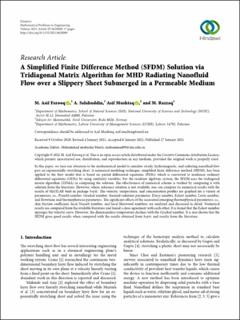| dc.contributor.author | Farooq, Muhammad Asif | |
| dc.contributor.author | Salahuddin, Aisha | |
| dc.contributor.author | Mushtaq, Asif | |
| dc.contributor.author | Razzaq, Mudassar | |
| dc.date.accessioned | 2021-03-17T11:04:22Z | |
| dc.date.available | 2021-03-17T11:04:22Z | |
| dc.date.created | 2021-02-05T09:26:55Z | |
| dc.date.issued | 2021 | |
| dc.identifier.citation | Farooq, M. A., Salahuddin, A., Mushtaq, A. & Razzaq, M. (2021). Unsteady MHD Bionanofluid Flow in a Porous Medium with Thermal Radiation near a Stretching/Shrinking Sheet. Mathematical problems in engineering, 2021: 6628009. doi: | en_US |
| dc.identifier.issn | 1563-5147 | |
| dc.identifier.uri | https://hdl.handle.net/11250/2733867 | |
| dc.description.abstract | In this paper, we turn our attention to the mathematical model to simulate steady, hydromagnetic, and radiating nanofluid flow past an exponentially stretching sheet. A numerical modeling technique, simplified finite difference method (SFDM), has been applied to the flow model that is based on partial differential equations (PDEs) which is converted to nonlinear ordinary differential equations (ODEs) by using similarity variables. For the resultant algebraic system, the SFDM uses the tridiagonal matrix algorithm (TDMA) in computing the solution. The effectiveness of numerical scheme is verified by comparing it with solution from the literature. However, where reference solution is not available, one can compare its numerical results with the results of MATLAB built-in package bvp4c. The velocity, temperature, and concentration profiles are graphed for a variety of parameters, i.e., Prandtl number, Grashof number, thermal radiation parameter, Darcy number, Eckert number, Lewis number, and Brownian and thermophoresis parameters. The significant effects of the associated emerging thermophysical parameters, i.e., skin friction coefficient, local Nusselt number, and local Sherwood numbers are analyzed and discussed in detail. Numerical results are compared from the available literature and found a close agreement with each other. It is found that the Eckert number upsurges the velocity curve. However, the dimensionless temperature declines with the Grashof number. It is also shown that the SFDM gives good results when compared with the results obtained from bvp4c and results from the literature. | en_US |
| dc.language.iso | eng | en_US |
| dc.publisher | Hindawi | en_US |
| dc.rights | Navngivelse 4.0 Internasjonal | * |
| dc.rights.uri | http://creativecommons.org/licenses/by/4.0/deed.no | * |
| dc.title | A Simplified Finite Difference Method (SFDM) Solution via Tridiagonal Matrix Algorithm for MHD Radiating Nanofluid Flow over a Slippery Sheet Submerged in a Permeable Medium | en_US |
| dc.type | Peer reviewed | en_US |
| dc.type | Journal article | en_US |
| dc.description.version | publishedVersion | en_US |
| dc.rights.holder | © 2021 The Author(s) | en_US |
| dc.subject.nsi | VDP::Matematikk og Naturvitenskap: 400 | en_US |
| dc.subject.nsi | VDP::Matematikk og Naturvitenskap: 400::Matematikk: 410 | en_US |
| dc.source.volume | 2021 | en_US |
| dc.source.journal | Mathematical problems in engineering | en_US |
| dc.identifier.doi | 10.1155/2021/6628009 | |
| dc.identifier.cristin | 1886991 | |
| dc.source.articlenumber | 6628009 | en_US |

